| Author |
Message |
    
Robert
Senior Member
Username: robert
Post Number: 303
Registered: 07-2003
| | Posted on Sunday, December 06, 2009 - 01:04 am: | 




|
I've got a little 3/4 NPT Schebler Model D with an air inlet in the bottom of the bowl.
Have seen lots of Schebler D's but never one like this.
There was a bit of screen soldered over the opening which I removed, which explains the solder residue in the photo. Originally I guess there was a small disc of brass mesh that was held over the hole by the screw.
Can anyone tell me what these were used for/on?
Thanks in advance!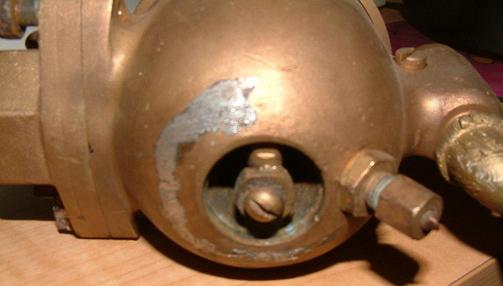 |
    
Ernie
Senior Member
Username: ernie
Post Number: 1121
Registered: 01-2002

| | Posted on Sunday, December 06, 2009 - 04:27 pm: | 




|
Robert,
Search for Schelbler on here and you will find pics and description.
Actually I can't seem to find it but it is on OME somewhere...I think...
It was another way they did the primary/secondary air control
Hope this helps
Ernie |
    
Robert
Senior Member
Username: robert
Post Number: 307
Registered: 07-2003
| | Posted on Sunday, December 06, 2009 - 11:29 pm: | 




|
Thanks Ernie, I did take a look, but not far enough I guess. |
    
Ernie
Senior Member
Username: ernie
Post Number: 1122
Registered: 01-2002

| | Posted on Monday, December 07, 2009 - 08:12 am: | 




|
If you look at the upper air horn with the adjustable valve and compare it to a regular one this one shouldn't have the small bypass passage |
    
Robert
Senior Member
Username: robert
Post Number: 308
Registered: 07-2003
| | Posted on Monday, December 07, 2009 - 12:06 pm: | 




|
Thanks again Ernie; would you mind explaining why and what you understand this air passage to have been for? I've been looking around the Schebler posts, but haven't found anything related. |
    
Ernie
Senior Member
Username: ernie
Post Number: 1123
Registered: 01-2002

| | Posted on Monday, December 07, 2009 - 01:27 pm: | 




|
Robert,
On all Schlebler "D" carbs the needle valve is adjusted at idle. The actual fuel mixture when running above idle "according to Schleblers instructions" is adjusted with the knob on the air valve at the top. The idea as to it being spring loaded was that it was designed to be load sensitive. However as in a previous discussion that is not always the case. I almost never touch the air adjustment.
So if you look in the air horn of a single air inlet Schlebler (the common one) there is a large hole that the spring loaded disc closes 100 percent. To the side of that is a small oval hole that is never covered. When the throttle is closed this small oval hole allows enough air so the spring loaded valve is stays closed. As the throttle is opened the spring loaded valve will lift off it's seat and hopefully keep the air/fuel ratio somewhere near where it is supposed to be.
The carb you have should have an air horn with out that small oval hole. The air for idle came through the bottom where the screen was soldered on yours. There was also an air horn that was attached by that screw in the center that went up the side of the float bowl and the actual air inlet was at about the level of the top of the float bowl.
I will try to find some pics
Any one have any?
Hope this helps
Ernie |
    
Searcher
Senior Member
Username: searcher
Post Number: 388
Registered: 10-2004
| | Posted on Monday, December 07, 2009 - 02:11 pm: | 




|
Here are two pre 1910 Schebler Ds. One has the horn coming off the bottom that Ernie mentioned, the other one has the brass screen and no horn.
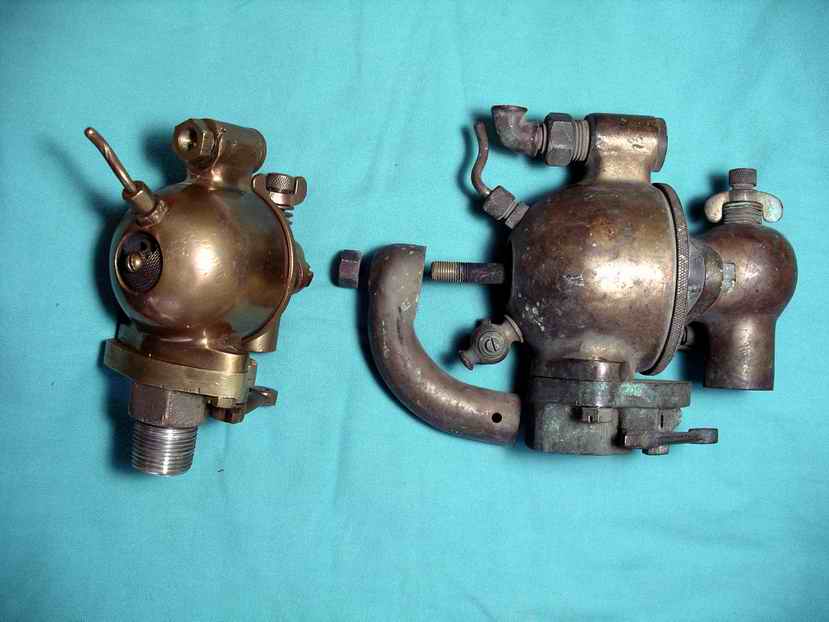 |
    
Ernie
Senior Member
Username: ernie
Post Number: 1124
Registered: 01-2002

| | Posted on Monday, December 07, 2009 - 03:06 pm: | 




|
I think the 3/4 in ones didn't have the extra air horn. Can you verify that they don't have the extra small oval hole by the air valve?
Thanks
Ernie |
    
Searcher
Senior Member
Username: searcher
Post Number: 389
Registered: 10-2004
| | Posted on Monday, December 07, 2009 - 03:46 pm: | 




|
Ernie, you are correct, there is no oval hole by the air valve in either of these or in a couple of others of this type I have. That air valve remains tightly sealed by a spring until conditions require the additional air. |
    
Robert
Senior Member
Username: robert
Post Number: 309
Registered: 07-2003
| | Posted on Monday, December 07, 2009 - 05:19 pm: | 




|
Thanks for the additional explanation Ernie.
Interesting to see the brass gauze in that one Searcher; it looks like a 3/4" carb, is it?
Mine has the marks of gauze and has no oval air hole either. I don't see any provision for the additional air 'horn'; perhaps that was not fitted on the smaller carbs?
I'm still unclear on what the purpose of this whole design feature was, as opposed to the usual Schebler Model D? |
    
Ernie
Senior Member
Username: ernie
Post Number: 1125
Registered: 01-2002

| | Posted on Monday, December 07, 2009 - 09:24 pm: | 




|
They were always looking for a better way...
Efficency...
Power...
Less need for adjustment once the initial adjustments were made and most likely many more reasons
To name a few |
    
Frank Petran
Senior Member
Username: frank_petran
Post Number: 74
Registered: 05-2009
| | Posted on Monday, December 07, 2009 - 10:35 pm: | 




|
I have a couple of Schleblers that have the oval air opening in them It seems that someone told me that these came from a Maytag or JD tractor. These carbs don't have the throle assy so I can't be sure what they fit. |
    
George Coates
Senior Member
Username: george_iv
Post Number: 82
Registered: 07-2003

| | Posted on Wednesday, December 09, 2009 - 09:16 am: | 




|
Let me start by saying "I know nothing." Now, what it looks like to me is a 1/2" carb with 3/4" necks. I've seen this before and one way to tell is the bolt sizes for the horns. If they are 1/4 - 20 it's a 1/2" carb. If they're 5/16 it's a 3/4" carb. The screen is the idle circuit for the smaller engines. The inlet horn probably does not have the tear drop/window/hole to allow the air to get past the fast run leather washer, but it may. I don't have any info saying these were used on any specific engine make, style, side draft/up draft, or whatever. I do have 2 of them which appear to be original (one still has a tag on it)and they are set up with the 3/4 horns.
Hope this helps, or at least raises more questions.
Ps. Be careful of the float size.
George IVy |
    
Robert
Senior Member
Username: robert
Post Number: 311
Registered: 07-2003
| | Posted on Wednesday, December 09, 2009 - 11:26 am: | 




|
That's interesting. Does anyone know the bowl diameters for 1/2" and 3/4" Schebler D's?
George, the screws on mine are 1/4-20, but I know this carb was together for decades - I glass beaded it to clean it up. It looks like 3/4 horns (throttle plates) were the norm, doesn't it?
I've never actually seen a Model D with a 1/2" thread. Considering how small the ID of Sch. 40 1/2" pipe is, I doubt a carb of this size could breathe properly through it, but then I don't know anything either! That's why I'm asking! ;-) |
    
George Coates
Senior Member
Username: george_iv
Post Number: 83
Registered: 07-2003

| | Posted on Wednesday, December 09, 2009 - 01:38 pm: | 




|
Here are pictures of a 1/2" with 1/2" NPT horns and 5/16 bolts (the nickel plated one). The other is a 1/2" with 1/4-20 bolts and 3/4" horns. Also the two fuel inlets are different. One has the screen and the other a drain.
Yep, I still no nothing...
George IVy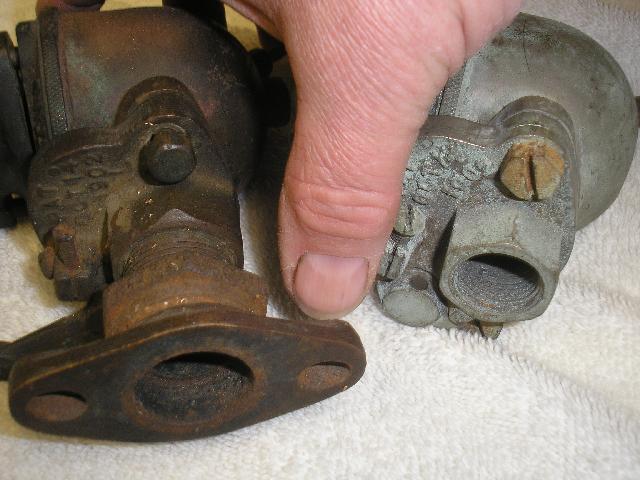 |
    
Robert
Senior Member
Username: robert
Post Number: 313
Registered: 07-2003
| | Posted on Wednesday, December 09, 2009 - 04:43 pm: | 




|
So perhaps they decided to standardize on 5/16 bolts at some point, and used the same bowl for both 1/2" and 3/4"?
The 3/4" carbs were standard on the 4-6hp Easthopes with a vertical throttle opening. Not sure on the bolt sizes will have to check what I have in storage.
Here's another I had; looks like 1/4-20 bolts and it was 3/4" of course.
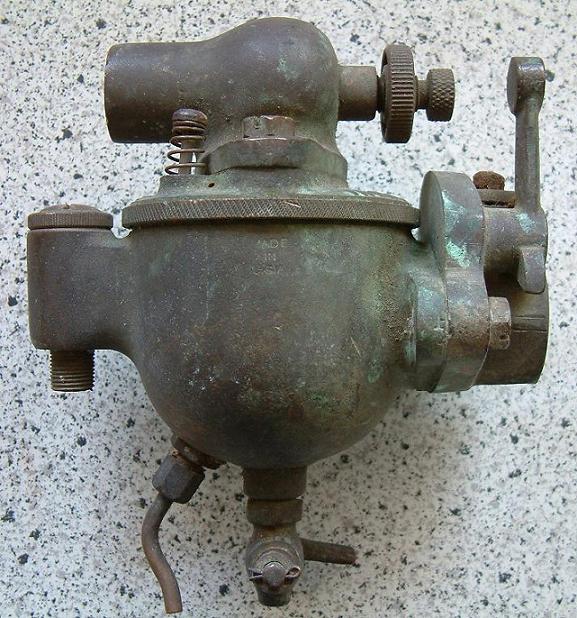
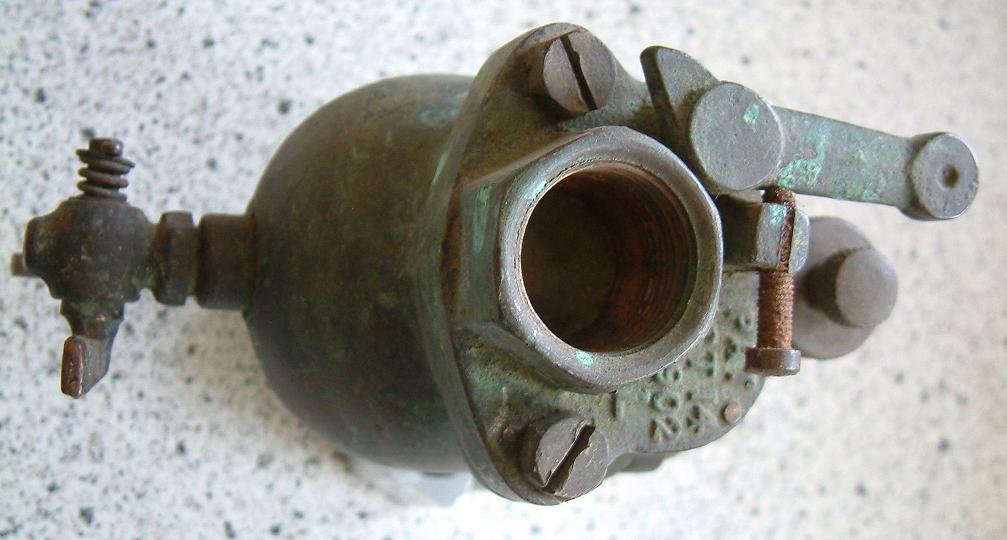
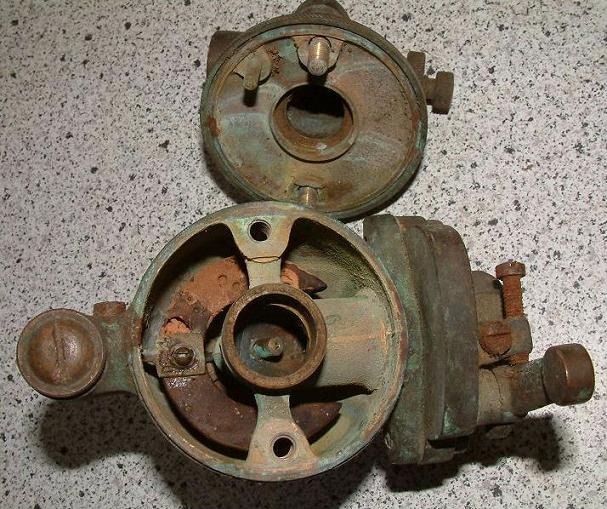
|
    
Ernie
Senior Member
Username: ernie
Post Number: 1129
Registered: 01-2002

| | Posted on Thursday, December 10, 2009 - 06:56 pm: | 




|
I just compared a couple of 1/2 and 3/4 carbs. The ones I have are identical except for the throttle body. |
    
Laurie Derwent
Member
Username: laurie_d
Post Number: 9
Registered: 10-2009
| | Posted on Sunday, December 27, 2009 - 10:31 pm: | 




|
I have 2 x 'Model D' carbies (1") for my 10/12 Simplex engines. One has a hole in the the float valve cap (I understand the hole is designed to drain fuel if the carby floods). The other does not have that hole (but it has a small round recess on the inside where the hole would nrmally be. Any advice as to which is the better one to use? I also note that Simplex mount the air horn facng towards the motor. I presume this means it will draw warm, dry air and reduce the risk of sray entering the carby. I don't like disturbing something that works but does anyone have thoughts about whether it is better to face the horn away from he motor? Regards |


